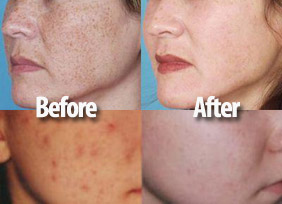Chemical Peel - light / deep - cosmetic procedure

Chemical Peel is a cosmetic procedure to smooth and tighten the surface of the SKIN, typically on the face, to improve the appearance of WRINKLES, scars, ACNE, widespread ACTINIC KERATOSIS, LENTIGINES (brown spots or liver spots), dyschromia (pigmentary irregularities), and other blemishes. The dermatologist applies a chemical solution, either an acid or phenol, to the selected areas of skin. The solution BURNS the skin, causing one layer or more of skin to slough off as HEALING takes place. The new skin that replaces the old skin is smoother, tighter, and lighter in color.
Light Peel: AHA Solutions
The lightest chemical peel is an alphahydroxyl acid (AHA) solution such as lactic acid or glycolic acid. It removes the top layer of skin (epidermis) and is appropriate for treating minor skin irregularities. The dermatologist puts the mild acid on selected skin sites in a series of applications or may mix the solution into a cream or wash for weekly home use until the peel produces the desired results. An AHA chemical peel causes mild irritation and discomfort that resolves as the skin heals. It generally takes six to eight weeks to see results with an AHA peel. An AHA peel requires frequent retreatment to maintain the effect.
Moderate Peel: TCA Solution
A moderate chemical peel uses a stronger acid solution, trichloroacetic acid (TCA), to remove the top and underlying layers of skin (epidermis and upper dermis). The dermatologist applies the TCA solution in one to three sessions spread over several months. A TCA chemical peel is appropriate for treating fine facial wrinkles and pigmentary irregularities. The treated area first forms a frothy coating and then scabs or crusts. The treated area also becomes swollen and may be uncomfortable enough to require mild PAIN relief medication for several days. Full healing takes about two weeks. The effects of a TCA peel generally last a year or longer, though many people need more than one treatment to achieve the desired results.
Deep Peel: Phenol Solution
A deep chemical peel extends through the dermis, the middle layer of the skin, to the hypodermis (innermost layer of the skin). It produces somewhat of a burn effect that causes complete loss and replacement of the skin. The dermatologist uses a phenol solution to achieve this result, which is appropriate for treating moderate facial blemishes, acne scars, sun damage, actinic keratosis, and most wrinkles. The application procedure takes about an hour, before which the dermatologist generally administers a sedating medication. Following the phenol application the dermatologist coats the treated area with petroleum jelly or other protective covering to reduce discomfort. The treated area is immediately raw and exposed, with scab formation in about 48 hours.
Swelling and discomfort are significant for a week or two after a phenol peel, and most people cannot participate in any regular activities during this time and may require assistance if the swelling causes their eyes to close. Proper care during healing is essential, and typically requires a regimen of ANTIBIOTIC MEDICATIONS and ointments to help keep the healing tissue moist and supple. The treated skin remains red and shiny for up to three months. Full healing takes four to six months, though most people can return to most normal activities in about three weeks.
The effects of a phenol peel typically last several years. The skin commonly loses its ability to produce melanin, however, making sunscreen and protective clothing such as a broad-brimmed hat essential to prevent sun damage and SUNBURN when outdoors. Most dermatologists recommend applying sunscreen daily, after healing, as a routine preventive measure. The loss of melanin also results in a permanently lighter pigmentation of the treated area. Because of this, people who have dark skin should not undergo phenol peels.
Chemical Peel Risks and Complications
Though chemical peels can produce smoother, more youthful looking skin, they do so by first damaging the skin so it must repair itself. The risks of chemical peels include infection, scarring, and irregularities in pigmentation after healing. Some people have adverse reactions to the chemical solutions. People who are prone to cold sores or FEVER blisters are likely to develop them during the healing phase; many dermatologists prescribe ANTIVIRAL MEDICATIONS to prevent these viral outbreaks from occurring. Phenol may exacerbate ARRHYTHMIA (irregularity of the heartbeat) in people who have arrhythmia disorders.
See also AGING, INTEGUMENTARY CHANGES THAT OCCUR WITH; BLEPHAROPLASTY; BOTULINUM THERAPY; COLD SORE; DERMABRASION; LASER SKIN RESURFACING; PLASTIC SURGERY; RHINOPLASTY; RHYTIDOPLASTY; SCAR; VITILIGO.